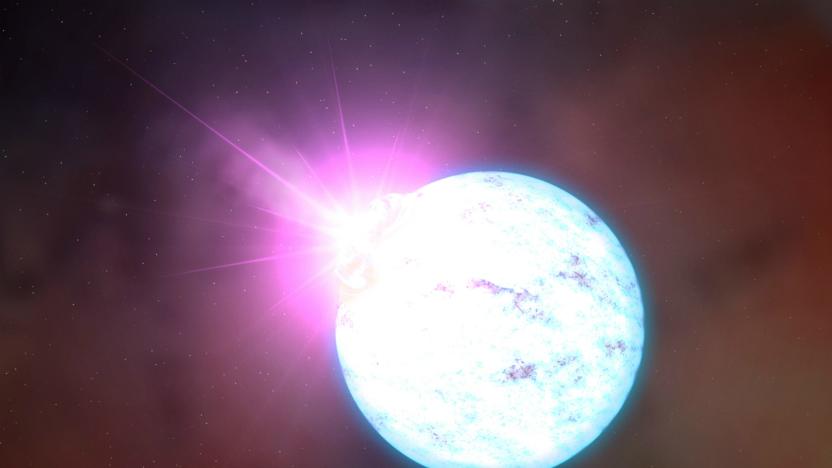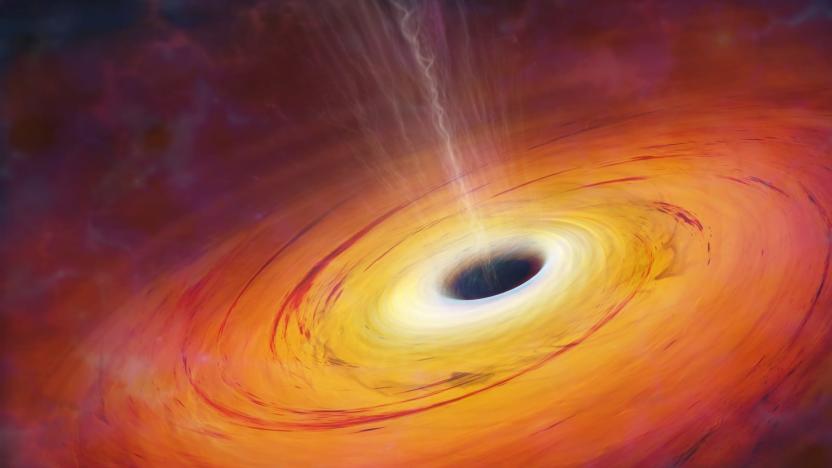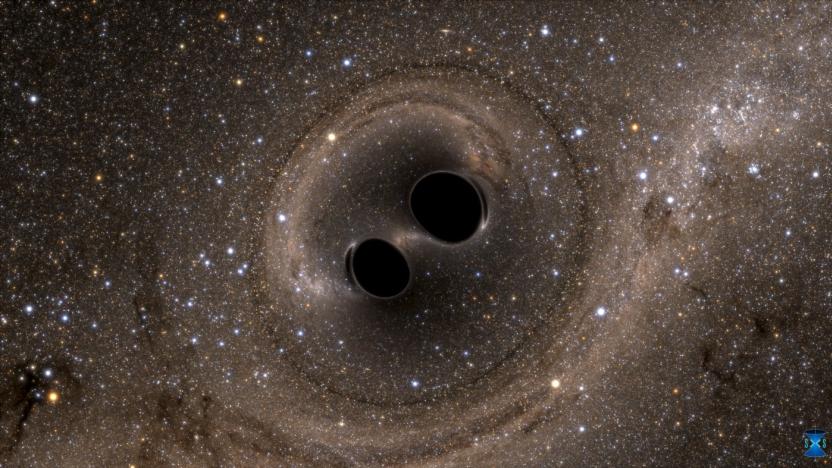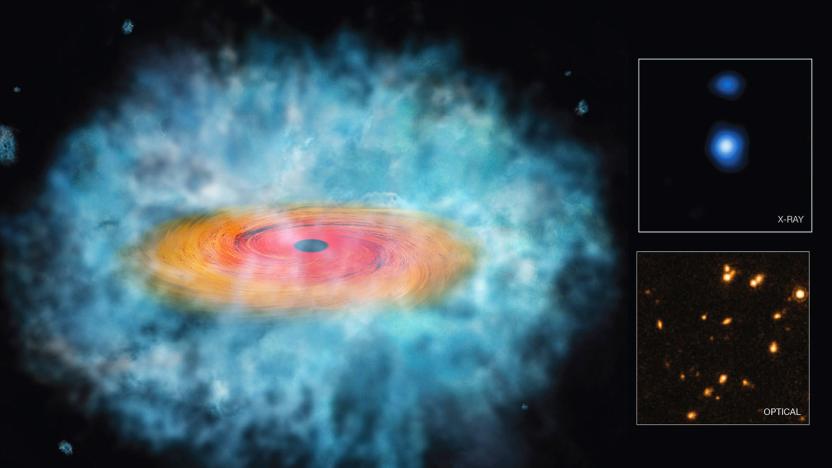BlackHoles
Latest

New computer models could direct scientists to epic cosmic events
Now that they're spotting gravitational waves more often, scientists are expanding their search for cosmic events. Specifically, they're using new computer models to depict the cataclysmic collision that occurs when a black hole joins a neutron star (the remnants of an exploded star). The simulations will help detectors track down the actual mergers using telescopes and advanced versions of LIGO (the Laser Interferometer Gravitational-Wave Observatory).

LIGO astronomers detect third black hole collision
Today, astronomers announced that LIGO has detected gravitational waves for the third time. As a result, scientists now may have new insights into how black holes are formed. Gravitational waves are ripples in the spacetime that travel at the speed of light. They're emitted as a result of black hole collisions, which produce incredible amounts of power. They had long been predicted by Albert Einstein's general theory of relativity, but it wasn't until September 2015 that LIGO's (the Laser Inferometer Gravitational-Wave Observatory) first direct observation occurred. A second detection quickly followed in December 2015. This third observation happened on January 4, 2017, and it's the furthest one yet, at 3 billion light years away. (The first two were around 1.3–1.4 billion light years away).

Event Horizon Telescope will soon take the first black hole photo
The Event Horizon Telescope (EHT) is finally ready to take a picture of Sagittarius A*. From April 5th to 14th this year, the virtual telescope that's been in the making for the past two decades will peer into the supermassive black hole in the center of our galaxy. EHT is actually an array of radio telescopes located in different countries around the globe, including the Atacama Large Millimeter/submillimeter Array in Chile.

NASA has a new plan to observe black holes with cosmic X-rays
Since humanity hasn't quite figured out a way to directly take a picture of black hole yet, NASA's next major science mission will send a trio of highly specialized telescopes into space to study the high-energy X-ray radiation surrounding black holes, neutron stars and pulsars. According to NASA's announcement today, the ultimate goal of the Imaging X-ray Polarimetry Explorer (IXPE) mission is to learn more about the gravitational, electric and magnetic fields at the edges of these cosmic phenomena.

Astronomers discover a nearby 'hidden' black hole
Astronomers compared data (and notes, we'd like to imagine) on a "peculiar" source of radio waves, concluding that what was once thought to be a distant galaxy is actually a nearby binary star system, made up of a low-mass star and a black hole. It took data from NASA's Chandra X-ray Observatory, the Hubble Space Telescope and the National Science Foundation's Karl G. Jansky Very Large Array (VLA) to realize this -- and now researchers reckon there could be more hidden black holes out there.

Computer simulations point to the source of gravitational waves
Since the first gravitational waves were successfully detected last September by the earthbound Laser Interferometer Gravitational-Wave Observatory (LIGO), scientists have wondered what made them. Today, researchers from the University of Warsaw published a theory suggesting that they were likely created by the collision of two black holes, which had been stars that formed 12 billion years ago.

Dark matter might be made of black holes
So just what is dark matter made of? Astronomer Alexander Kashlinsky of the NASA Goddard Space Flight Center in Maryland thinks the mysterious cosmic stuff could be made of black holes that formed soon after the Big Bang.

ICYMI: Gravitational waves and holographic Holocaust memory
try{document.getElementById("aol-cms-player-1").style.display="none";}catch(e){}Today on In Case You Missed It: NASA's mission to figure out where black holes are located won't actually deploy until 2034, but the science behind the sound experiment is being worked on now. University of Southern California's Institute for Creative Technologies created a 3D video rig to capture people's memories, saving the video and sound mash-up for future generations to hear first-hand accounts of the Holocaust. The "In Good Company" shoe for turning off phone notifications automatically is here; in case you're interested in the human ancestor story, NPR has a good summary here. As always, please share any great tech or science videos you find by using the #ICYMI hashtag on Twitter for @mskerryd.

Scientists believe supermassive black holes had speedy births
Supermassive black holes found in the center of galaxies like the Milky Way might be super-huge, because they were born big in the first place. A team of astronomers from the Scuola Normale Superiore in Italy found evidence that these gigantic celestial objects thousands to millions of times larger than our sun came from a special type of black hole seeds. These seeds formed "directly from the collapse of giant gas clouds" and didn't have to go through any intermediate steps, such as the explosion of a star.

Astronomers are using pulsars to spot gravitational waves
Earlier this month scientists detected gravitational waves, but it wasn't easy. Because of the tiny forces involved, it took us nearly 100 years to confirm Einstein's original prediction that ultra-massive objects like black holes could send ripples across space-time. A team of astronomers from a group called NANOGrav thinks it can use stable pulsar signals to track tiny movements in the Earth when it's jostled by gravitational waves. "Detecting this signal is possible if we are able to monitor a sufficiently large number of pulsars spread across the sky," says Stephen Taylor from NASA's Jet Propulsion Laboratory. "The smoking gun will be seeing the same pattern of deviations in all of them."

Stephen Hawking believes he knows how information escapes black holes
Stephen Hawking announced during a lecture at the KTH Royal Institute of Technology in Stockholm, Sweden on Tuesday that he has potentially solved the Information Paradox. The paradox a conflict between the quantum mechanics and general relativity models that has vexed physicists for more than four decades. The Information Paradox arises from black holes -- specifically what happens to information about the physical state of objects that fall into one. The quantum mechanical model posits that the information remains intact while general relativity argues that it is indeed obliterated under the black holes immense gravitation. But Hawking has developed a third opinion: the information never actually makes it into the black hole. "I propose that the information is stored not in the interior of the black hole as one might expect, but on its boundary, the event horizon," he said.

The Universe might contain millions of hidden black holes
Black holes are, by definition, impossible to see by conventional methods and are often further obscured by thick blankets of dust or gas. But that's not an issue for NASA's Nuclear Spectroscopic Telescope Array (NuSTAR). It can peek through the obscuring layers and monitor the black holes via the high-energy X-rays that they emit. And, after a recent survey that spotted five previously unknown supermassive black holes in the centers of various galaxies, NASA researchers now think there could be millions of of them dotting the Universe like the holes of an intergalactic colander.

NASA finds distant galaxy shining as bright as 300 trillion suns
Ever tried looking at the sun with your bare eyes? Too bright, right? Now imagine looking at something with the brightness of 300 trillion suns. That's how intense "the most luminous galaxy found to date" is, so much so that NASA has created a new classification for it and the 19 other similar galaxies it has discovered: extremely luminous infrared galaxies, or ELIRGs. Scientists have recently spotted the ELIRGs in infrared images of the sky taken by the agency's Wide-field Infrared Survey Explorer (WISE) space telescope in 2010. This particular one is located 12.5 billion light years away, which means it started forming soon after the universe was born 13.8 billion years ago. As for why it's so incredibly brilliant, NASA JPL scientist Chao-Wei Tsai says it "may be from the main growth spurt of the galaxy's black hole."

Hungry, hungry black holes gobble up huge gas and dust donuts
According to a new study using NASA's Chandra X-ray Observatory, there's a breed of supermassive black holes out there a lot more ravenous than usual. Supermassive black holes are found in the middle of galaxies, measuring millions to billions of times the mass of our Sun. Some of them actively consume gas and dust, which form a "disc" around the mass -- as matter from that disc fall into the black hole, a jet of particles stream out, appearing as cloudy streaks. These are called quasar black holes, and they usually shine more brightly than the galaxy itself, since that disc radiates huge amounts of energy. The ones discovered by Bin Luo and his team of astronomers, however, "[dine] at enormous rates, at least five to ten times faster than typical quasars."

New telescopes could uncover a wormhole in our own galaxy
If you're ever unlucky enough to be sucked towards a super-dense black hole, you'll soon arrive at something called the event horizon -- from which nothing can escape, including light. Thanks to a new "earth-sized" radio telescope, scientists may soon know whether you'll become stretched out infinitely ("spaghettified") or merely vaporized. Knowing which of those gory fates is correct will help astronomers in their quest to unify Einstein's theories involving planetary motion with sub-atomic quantum mechanics. Even more intriguingly, a separate telescope experiment called GRAVITY in Northern Chile may soon tell us if the Sagitarius 'A' black hole at the center of our own galaxy is actually a wormhole instead.

Alt-Week 12.7.13: Wormhole short-cuts, watery planets and history as seen by Google Books
Alt-week takes a look at the best science and alternative tech stories from the last seven days. Don't pack your bags just yet, but Hubble has found indirect evidence of water on five different planets -- a lot of it, in some cases. Bigger brains than ours are also speculating that like black holes, distant particles can be bridged by a wormhole, creating space short-cuts. Back on earth, a new book called Uncharted tackles nothing less than all the trends in recorded history using eight million Google books. No big whoop, right? It's Alt-Week.

Scientists release biggest ever 3D map of the universe, lacks turn-by-turn navigation (video)
The stargazers at the Harvard-Smithsonian Center for Astrophysics have released a huge three-dimensional map of outer space, a core part of its six-year survey of the skies. Encompassing four billion light-years cubed, the researchers hope to use the map to retrace the movements of the universe through the last six billion years. Using the latest Sloan Digital Sky Survey (SDSS-III), the center says the data will help improve their estimates for the quantity of dark matter in space and the effect that dark energy has on the universe's expansion, "two of the greatest mysteries of our time" -- if you're an astrophysicist. Even if you're not, you'll still want to board the animated flight through over 400,000 charted galaxies -- it's embedded after the break.

Giant body of water found in space, black hole claims it was just hydrating
Is that an intergalactic wave pool, or just a hungry, hungry quasar? Turns out it's a bit of both -- well, not the wave pool bit, but it's watery. A NASA-funded peep into the farthest reaches of the cosmos has uncovered this "feeding black hole" 12 billion light years away. APM 08279+5255, as this compacted mass of inescapable doom is affectionately known, has been gorging on water vapor and spewing out energy. How much H2O exactly? It's only the "largest and farthest reservoir of water ever detected in the universe," and it weighs in at 140 trillion times the amount in our oceans. Located via the cooperation of two teams of astronomers and their star-gazing equipment -- the Z-Space instrument at California Institute of Technology's Submillimeter Observatory in Hawaii and the Plateau de Bure Interferometer in the French Alps -- this aqueous discovery proves the wet stuff is more universally omnipresent than we once thought. Also, surfing aliens, right?

String theory finds an elegant use for itself with qubit entanglement and black holes
Sure, trying to wrap your head around string theory -- a study in particle physics that's trying to rectify the perceived contradictions between general relativity and quantum mechanics -- can cause more cognitive pain than a colliding god particle. That hasn't stopped anyone from trying to validate its corollaries, and in the interim, researchers like Michael Duff of the Imperial College London. Mr. Duff realized a few years ago there existed some strong relations between formulas pertaining to both black holes (relativity) and four entagled qubits (quantum mechanics). So, in his words, "In a way, there's bad news and good news in our paper. The bad news is, we're not describing the theory of everything. The good news is, we're making a very exact statement which is either right or wrong. There's no in between." We're sure some science cliques are already gearing up to get their troll on. Hit up the PDF below if you want to read it yourself.

Astronomers theorize what it's like when worlds (and black holes) collide
Tight binary solar systems are inhabited in science fiction -- remember the Star Wars world of Tatooine -- but humanity might find such planets inhospitable over the long term, and not just because of the heat. Using NASA's Spitzer telescope, scientists discovered clouds of dust around three such binary systems far too recent to come from the stars themselves, and theorize that as the stars attract one another over time and get closer and closer together, their respective orbiting planets may get closer as well, and crash into one another catastrophically. Meanwhile, when supermassive black holes dance in pairs, they can merge as one, and astrophysicists have recently simulated how such a joining might appear on our telescopes. According to a team of US and Canadian researchers, the pair may emit strong jets of electromagnetic radiation before they merge, which twist around one another and throw off gravitational waves that can help pinpoint the source. Speaking of sources, we've got plenty of those immediately below if you'd like to read more.








